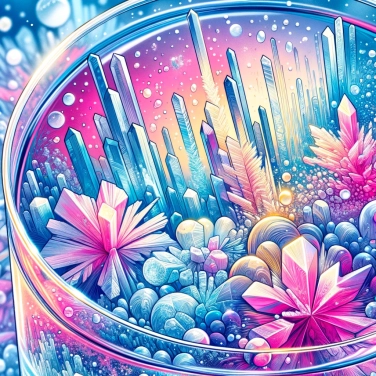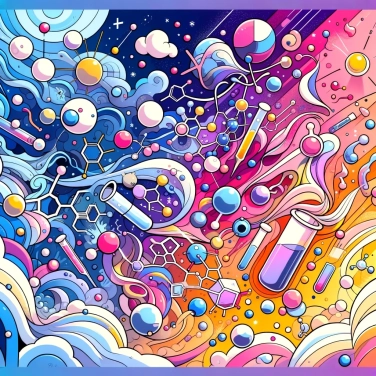When water freezes, water molecules align themselves in a regular pattern to form crystals, as this structure is the most stable at low temperatures. This process of crystallization allows water to transition from a liquid state to a solid state.

Water is made up of molecules composed of oxygen and hydrogen (H₂O), which cling to each other through special bonds called hydrogen bonds. This type of bond is a bit like small invisible hands that hold the molecules together. The "V" shape of these molecules makes their arrangement particularly orderly as they cool down. Essentially, when it cools, the molecules move more slowly, and these small invisible hands naturally align them in a regular pattern. It is this precise organization that gives rise to the famous ice crystals, regular and very symmetrical.
When you cool water, the molecules gradually slow down and their thermal energy decreases. At room temperature, these molecules move in all directions and slide easily against each other. As the temperature drops, their agitation decreases, until at 0°C they have so little energy that they begin to freeze in place. As a result, they organize into a stable, regular structure, aligning with each other through their hydrogen bonds. Transitioning from a chaotic liquid state to a well-organized solid structure, water then becomes ice through this phenomenon called solidification. During this change, it releases heat into the environment. That’s why, even if the temperature remains constant at 0°C during complete solidification, water continues for a while to release energy in the form of heat: this is called latent heat of solidification.
When water cools down, its molecules slowly slow down and start to agitate less. Around 0°C, they naturally organize themselves into hexagonal networks, forming regular patterns. Each water molecule then finds its place by creating four bonds with its neighbors, thanks to hydrogen bonds. This precise arrangement creates an open and spaced structure, which gives ice a lower density than liquid water and explains why ice cubes gently float in your drink. The gradual assembly of these tiny microscopic hexagons spreads, building larger crystals visible to the naked eye, recognizable by their remarkable geometries. It is this repeated hexagonal architecture that shapes the typical forms of snowflakes, all unique but always faithful to this six-branch pattern.
Temperature is the primary parameter; it directly controls the speed of cooling and the type of crystals formed. Rapid cooling typically creates smaller and less regular crystals, whereas slow cooling allows molecules to organize better, resulting in larger crystals with a nice regular structure. Next, there is the humidity of the air: a humid atmosphere promotes the growth of crystals, allowing them to become larger and more detailed. In contrast, dry air will limit the size and complexity of these crystals. Atmospheric pressure also plays a role: when it decreases, as at higher altitudes, water freezes more easily, but crystallization may be different than under normal pressure. Certain specific conditions, such as slight vibrations or water movement, can disrupt molecular organization during freezing, directly influencing the final shape of the resulting crystal.
Impurities in water, such as dissolved minerals, dust, or certain gases, disturb the perfect creation of ice crystals. When these intruders become embedded in the freezing process, they disrupt the regular organization of water molecules, thereby altering the shape and size of the final crystals. For example, a little salt can prevent water molecules from forming uniform and regular crystals by lowering their freezing point, which explains why roads are salted in winter! Because of these impurities, the crystals can become more irregular, disordered, or fragmented, creating an imperfect crystalline structure. This imperfection often makes the ice more fragile and brittle instead of solid and durable. This is also why an ice cube made from tap water appears less clear and uniform than one made from distilled water, which is purer and more transparent.
Snow crystals almost always have a hexagonal structure (with six branches): this is due to their unique molecular organization, related to the specific angles of the hydrogen bonds formed by water molecules.
Unlike most substances, solid water (ice) is less dense than liquid water, allowing lakes and oceans to freeze on the surface and protecting the underlying aquatic life during winter.
Each ice crystal has a unique structure, influenced by the specific atmospheric conditions (temperature, humidity, pressure) in which it formed, which is why the famous saying goes: "no snowflake is exactly like another."
Under certain extreme conditions, water can remain liquid even below 0°C: this phenomenon is called supercooling. Sometimes, a slight vibration or the presence of an impurity is enough to trigger sudden crystallization.
Theoretically, yes. At standard atmospheric pressure, pure water begins to freeze precisely at 0°C. However, in practice, certain factors such as pressure, impurities, and even specific environmental conditions can slightly cause this temperature to fluctuate.
Transparent ice forms slowly, allowing dissolved gases to be gradually expelled and the crystalline structure to develop evenly. Opaque ice forms quickly, trapping air bubbles and impurities that scatter or reflect light, giving it a cloudy and opaque appearance.
The safety of ice largely depends on its source and environmental conditions. Natural ice, such as that from a lake or river, may contain microbes, viruses, or chemical pollutants. Therefore, it is recommended to melt and then boil this water or to use an appropriate filtration system before consumption.
Unlike most substances, water expands in volume when it freezes due to its unique hexagonal crystal structure. When water molecules freeze, they arrange themselves into a rigid network that is less dense than liquid water. This results in a volumetric expansion of about 9%, which explains why ice floats on liquid water and can cause pipes to crack in winter.
The hexagonal shape of snowflakes is explained by the crystalline structure of water: it crystallizes by arranging its molecules in a hexagonal molecular structure, primarily due to the geometry of the hydrogen bonds between water molecules. This naturally leads to a hexagonal development of the snowflake as it grows.

100% of respondents passed this quiz completely!
Question 1/5